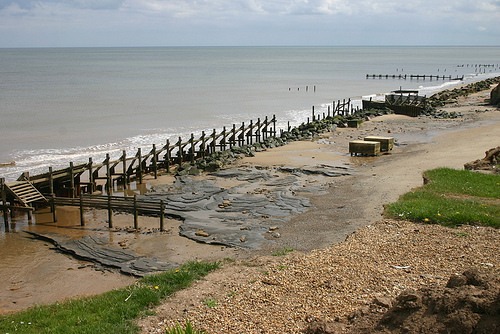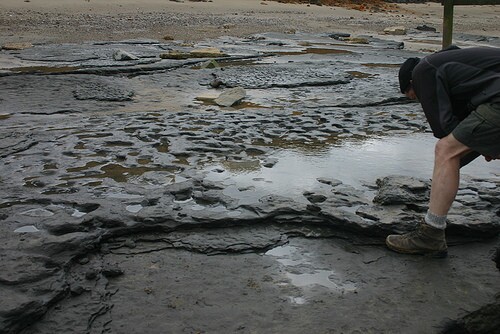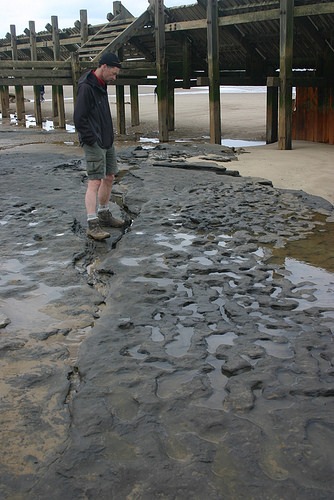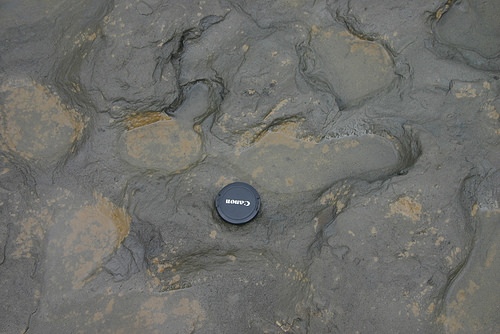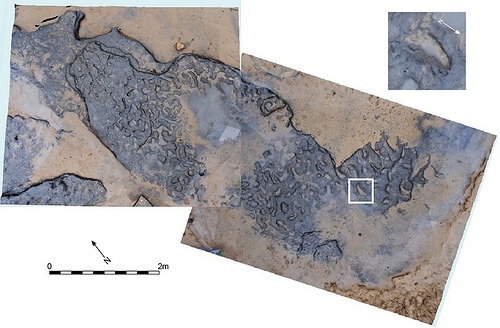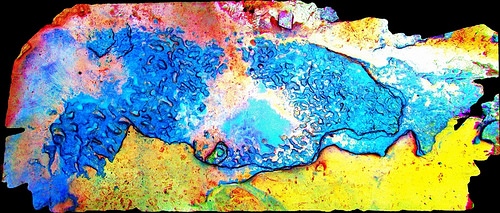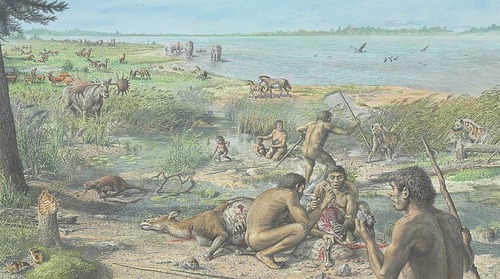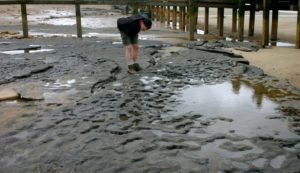
It was an almost desperate race against time. On one side was the ocean, its relentless incoming and outgoing tides beating and constantly reshaping the beach, as any ocean would do. On the opposite side were the overlying cliffs, the erosion of which through time helped to expose a series of small hollows, what appeared to be human footprints, on an ancient beach surface dated hundreds of thousands of years into the past. This team of scientists knew they had only a short window of time to observe and record them before the elements erased the hollows back into oblivion.
“When we first saw them, we were in a state of initial disbelief, but once we’d ruled out all the other possibilities we were utterly amazed that, first, they survived, and second, that we happened to be there during the few days that they were exposed,” said Nick Ashton, a curator with the British Museum for over 25 years. Ashton is also the Director of the Ancient Human Occupation of Britain Project (AHOB) funded by the Leverhulme Trust. He has been directing the oceanside Happisburgh Paleolithic excavations, where these footprint finds were located. The site has yielded evidence of a human presence as far back as 800,000 years ago, and the footprints tell a story of humans who may have walked this place even more anciently.
But Ashton and his team faced a serious challenge. Their task to initially examine and document them could only be measured in a few weeks, if not days.
“The first problem was mobilizing a team to record them,” said Ashton. “But Sarah Duffy from York University stepped into the breach, coming down at short notice to record them using multi-image photogrammetry.” Duffy is an archaeologist with specialized expertise in digital imaging techniques as they apply to archaeology.
“The weather was foul,” he added. “We couldn’t get down to the beach until just after 5 pm just as it started to lash with rain. Heavy seas meant that there were only 3-4 hours in which to record them, but first we had to remove the beach sand that had accumulated since the last tide and remove the excess water from the hollows. As Sarah started the recording we were continually using sponges to remove the persistent rain-water. By this time the light was fading, despite being May and I really had little faith in the technique working. We eventually left the beach cold, wet and somewhat demoralized. However, the results were stunning.”
Above and below: Area A (which includes the hollows/footprints) at Happisburgh from cliff top looking south. (Photo: Martin Bates).
The imaging showed that the hollows were elongated, like the shape of a foot, and the majority of them fell within the range previously determined through paleoanthropological research as juvenile to adult hominin foot sizes. “In many cases, the arch and front/ back of the foot can be identified and in one case the impression of toes can be seen,” write Ashton and colleagues in their more recent research report.*
Moreover, further study indicated that they were dealing not with just one individual, but a group of perhaps five individuals of mixed ages — perhaps an adult and several children. And whoever they were, they were apparently moving in a southerly direction along mudflats of an ancient estuary of a tidally-influenced river.
_________________________________________________________________________________________
Above and below: The footprint hollows in situ on the beach at Happisburgh. (Photos: Martin Bates).
Above: Detail of footprint surface. (Photo: Martin Bates)
Vertical image of Area A at Happisburgh with model of footprint surface produced from photogrammetric survey with enlarged photo of footprint 8 showing toe impressions. © Happisburgh Project
Enhanced 3D model of footprint surface produced from photogrammetric survey by using color to indicate depth. © Happisburgh Project
But perhaps the biggest find had to do with age. The ancient laminated silt layers in which the footprints were found were directly associated with ancient laminated silt layers and lag gravels that had already been dated nearby. Artifacts, flora and fauna found within those layers helped to pinpoint the age range.
“An artefact assemblage has been recovered from these lag gravels, consisting of flint flakes, flake tools and cores. The sediments also contain a rich assemblage of fauna and flora which suggest that the archaeological evidence can be attributed to the later part of an interglacial. This interglacial is dated on the basis of biostratigraphical and palaeomagnetic evidence to the latter part of the Early Pleistocene, perhaps MIS 21 or MIS 25,” reported Ashton and colleagues.*
In other words, the footprints, according to Ashton and his research team, are dated to between ca. 1 and 0.78 million years ago.
The finding was astounding. This meant that this was the oldest known hominin footprint surface outside of Africa. It pushed the record of human occupation of northern Europe back by at least 350,000 years.
The footprints have become a major a milestone in a series of discoveries beginning in 2000 at this location, named after the nearby village of Happisburgh on the coast of eastern England.
“The first evidence of Palaeolithic archaeology was a handaxe found by a local person walking their dog (Mike Chambers),” said Ashton. “Although this dates to 500,000 years ago, it led to further fieldwork and the discovery of ‘Site 3’ dating to 800,000 years old and subsequently the footprints.”
Happisburgh has been found to feature a remarkable concentration of Early Stone Age, or Lower Palaeolithic, sites that were buried in time under glacial sediments and subsequently exposed in time as a result of coastal erosion. Thus far, excavations have revealed numerous artifacts as well as butchered large mammal bones and other biological remains across five identified sites, tell-tale signs of a human presence during a cool climatic period around 500,000 years ago and earlier. At “Site 3”, the location of the recently discovered footprints, about 80 stone tools have been uncovered during large scale excavations from 2005 to 2010. Studies have shown that this area was once the location of an ancient river channel. The river was the ancestral river of the current Thames which, hundreds of thousands of years ago, flowed into the North Sea 150 kilometres north of its present day estuary.
Research on the plant and animal remains recovered from the site have afforded archaeologists and other scientists the opportunity to reconstruct the climate and environment of the area as it existed more than half a million years ago, at the time the artifact-bearing sediments were deposited. They found that these early humans occupied the area during a cooling period when a conifer woodland was predominant:
From palynological analysis of adjoining sediments, the local vegetation consisted of a mosaic of open coniferous forest of pine (Pinus), spruce (Picea), with some birch (Betula). Alder (Alnus) was growing in wetter areas and there were patches of heath and grassland. This vegetation is characteristic of the cooler climate typically found at the beginning or end of an interglacial or during an interstadial period….*
To date, no human fossil bones have been excavated at Site 3 or any of the other four sites. But now, analysis of the footprints, combined with current knowledge about early human occupation of Europe, are providing some clues about who these people were and how they might fit into the developing landscape of the first humans in the European geographic arena.
_______________________________
Reconstruction of Happisburgh, over 800,000 years ago. © John Sibbick
_______________________________________
Measuring the Evidence
The researchers measured a total of 152 hollows/footprints, indicating a preponderance of elongated forms and shapes, form features and measurements that suggested they were made by perhaps 5 individual humans of varying size and age. Foot size yielded estimates of height. Most significantly, the dimensions seem to fit neatly into the range identified through previous studies and archaeological investigations as attributed to an early human form that is known to have occupied Europe during the Middle Pleistocene.
“Overall the estimated foot size, foot area and stature of the Happisburgh hominins correspond with the estimates for Homo antecessor,” report Ashton, et.al.*
Homo antecessor (or H. antecessor) — the name derives from landmark human fossil discoveries made at the archaeological cave sites of Gran Dolina and Sima del Elefante at the Sierra de Atapuerca mountain in northern Spain. There, archaeologists Eudald Carbonell, Juan Luis Arsuaga and J. M. Bermúdez de Castro discovered fossil evidence of an extinct human species that lived between 800,000 to 1.2 million years ago. Carbonell and his colleagues estimate that the adult H. antecessor stood about 1.6-1.8 m (5½-6 feet) tall, similar to the recent estimates from Happisburgh (ca. 0.93 for the juvenile and 1.73 m for the adult), and weighed roughly 90 kg (200 pounds). Their brain sizes are estimated to be 1,000–1,150 cm³, smaller than the 1,350 cm³ average for modern humans. But because the fossil evidence is comparatively scarce, little else is known about the physiology of this ancient human species. To date, these sites are the only locations where fossilized remains of the species have been found, but the finds have interjected a new chapter in the developing picture of human evolution and the advent of early humans (hominins) on the European subcontinent.
So now, Happisburgh adds yet another discovery to the mix: H. antecessor, or something like it, occupied the northern parts of Europe, or at least the region today known as the UK, as much as 1 million years ago.
Walking the Beach
The evidence thus far could present an intriguing, albeit incomplete picture of what could be going on in this place so long ago. Informed by the findings and what he already knows about the prehistory of the area and the interdisciplinary science thus far applied to human beginnings in this part of the world, Ashton paints a hypothetical picture:
“We appear to be dealing with a small family group walking along the muddy fringes of an estuary perhaps 10 to 15 miles from the coast. It would be nice to imagine that they’re pausing in their walk to collect shell fish, crabs and possibly seaweed. Around would have been the grassy floodplain, grazed by deer, horse and bison together with more exotic animals such as rhino, hippo and elephant. In the distance coniferous forest would have dominated the surrounding hills.”
With more work, this picture could become much larger with greater detail. But time is of the essence. As Ashton reports:
The rarity of such evidence is equalled only by its fragility at Happisburgh, where severe coastal erosion is both revealing and rapidly destroying sites that are of international significance. The pre-glacial succession around Happisburgh has now revealed several archaeological locations of Early Pleistocene and early Middle Pleistocene age with evidence of flint artefacts, cut-marked bones and footprints. Importantly, the sites are associated with a rich environmental record of flora and fauna allowing detailed reconstructions of the human habitats and the potential for preservation of organic artefacts. Continuing erosion of the coastline will reveal further exposures of the HHF and new sites, which promise to transform our understanding of the earliest human occupation of northern latitudes.*
“We’ll be continuing to work in the area as new information is revealed every time we visit,” he says. “Over the years we have built up a team of local people who walk the beaches on a far more regular basis and are excellent at reporting back any new discoveries, whether these be new sediments, artifacts or fossil bones.”
Dr Nick Ashton, British Museum at the Happisburgh site. Dr Ashton is the Co-Director of the Happisburgh Project and the British Museum’s curator of the Palaeolithic collections. Photo: Happisburgh Project
Prof. Chris Stringer, a key author of the study report on the Happisburgh footprints. © Trustees of NHM: Professor Chris Stringer © Trustees of Natural History Museum
______________________________
Did you like this? Find out more about Popular Archaeology and how you can subscribe for access to more premium articles.
______________________________
Cover Photo, Top Left: Photograph of the footprint hollows in situ on the beach at Happisburgh, Norfolk. (Photo: Martin Bates).
___________________________________________________

